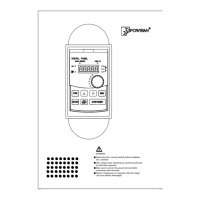VDI is valid or invalid state depending on the VDO output valid or invalid, and VDIx
only binding VDOx(x=1~5)
When choosing VDI state selection function code to set, through the binary bits of E3.05,
respectively determine the state of virtual input terminals.
Example of how to use VDI.
Example 1. Implement following function: “Inverter fault alarm and shuts down when AI1
input exceeds upper or lower frequency” .
Realize by following settings: Set VDI state decided by VDO, set VDI1 function as “ user
defined fault 1” (E3.00=44); set VDI1 terminal state effective mode decided by VDO1
(E3.06=xxx0); set VDO1 output function as “AI1 input exceeds upper & lower
frequency” (E3.11=31); so when AI1 input exceeds upper or lower frequency, VDO1 state
is ON, VDI1 input terminal state is effective, VDI1 receive user defined fault 1, inverter
then alarm fault no. 27 and shuts down.
Example 2. Implement following function: “Inverter run automatically after power-on”.
Realize by following settings: set VDI state decided by function code E3.05, set VDI1
function as “FORWARD” (E3.00=1); set VDI1 terminal state effective decided by
function code (E3.06=xxx1); set VDI1 terminal state is effective (E3.05=xxx1); set
command source as “terminal control” (F0.11=1); set protection selection as “no
protection” (F7.22=0); so after inverter powered on and initialization complete, VDI1
detected effective, and it match forward running, then inverter starts running forwardly.
This group function code is used when using AI as DI, when AI used as DI, and input
voltage of AI is greater than 7V, AI terminal status will be high level, when input voltage
of AI is lower than 3V, AI terminal status will be low level. For between 3V~ 7V
hysteresis E3.10 is to determine that when the AI is used as DI, AI is made valid by means
of the high level state, or the low level of valid states. As for AI as DI feature set, same as
the ordinary DI Settings, please refer to the F1 group setting instructions related DI.

